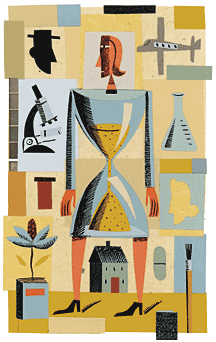
The naked artist stares out from the canvas, clasping in one hand a paintbrush, in the other, a cloth to wipe off mistakes. Her bold gaze reveals no shame in the sag of her belly or in any other sign of her eight decades of life.
“It’s very honest, very direct, something that not many artists have dared to do,” observed Dr. Christine Poggi, associate professor of the history of art, of the image projected on the screen behind her. In this self-portrait by the late modernist painter Alice Neel, Poggi said, there is “a sense of accepting the body, a sense of even celebrating it in its old age as part of what made [the artist] who she was—this very uninhibited, flamboyant, bohemian individual.”
After a year of pondering time in all of its permutations, the Penn Humanities Forum concluded its interdisciplinary series of public lectures, readings, and exhibits on May 1 with a panel discussion on “Time’s Potential: The Past, Present, and Future of Aging.” Seven scholars gathered in Houston Hall to talk about the late styles of artists, writers, and composers; the future of health care and Alzheimer’s research; and the ways in which people experience time as they age.
British novelist Penelope Fitzgerald published 13 books in the last 25 years of her life. “What intrigues me most about her work is the way she keeps extending herself beyond her own experiences,” said Dr. Susan Stewart, the Donald T. Regan Professor of English. “Her first novels were based on incidents in her own life,” such as living on a houseboat and running a failed bookshop. “But she went farther and farther in time and space.” In her prize-winning The Blue Flower, Fitzgerald “recreates the mental world and historical context of the mythical Romantic German poet Novalis.”
Fitzgerald herself explained in an interview two years before her death, at age 83: “I remain true to those who were born to be defeated,” adding that “the tragedy of misunderstandings and missed opportunities, I have done my best to treat as comedy—for otherwise how could you manage to bear it?” Fitzgerald believed that the “tolerance and wry humor” characteristic of her works had “something to do with the perspectives that come from living a long life … ”
But what time bestows—freedom, insight, boldness—it can also take away. Dr. John Trojanowski, co-chair of the Center for Neurodegenerative Diseases, presented an update on Alzheimer’s disease research, noting that the incidence of the disease increases “exponentially” after age 65.
“If we could shift [the onset back] by about five years,” he said, “far more people could live to age 80 or 85 or 90 without experiencing Alzheimer’s disease. I’d like to believe in my lifetime, certainly in the next 20 years, we’ll have new drugs on the market that will accomplish that goal.
“If you gave me $10 million, I could spend it very quickly over five years on multiple, very promising therapeutic interventions,” Trojanowski said, “but it takes a long time to go from the laboratory to clinical trials.”
Long before the advent of the Penn Humanities Forum, Dr. Neville Strumpf, Edith Clemmer Steinbright Professor of Gerontology and former interim dean of the School of Nursing, did her doctoral dissertation on the meaning of time for older women. “I marvel now at the study’s limitations,” Strumpf said, “but nevertheless found instructive these observations” gleaned from interviews with 86 older women: “The future, however defined, is important. Thinking young is critical to one’s self esteem. And staying in tune with the present is crucial, although the past was usually seen as the happiest time.” The survey, Strumpf said, “continues to underscore for me the need … to see beyond the immediate chronic illnesses of older people to consider the impact of environment.”
On a recent visit with a nature-loving friend named Barbara, who lives in a special-care unit for persons with Alzheimer’s disease, Strumpf proposed a walk outside. “Painstakingly and carefully I conjured up memories of trips together in the Adirondacks, commenting on the Canada geese flying overhead, and repeating the names of the spring flowers spread out before us,” she recalled. “I looked readily into her eyes, stroking her back, her arms. We … felt the warmth of the sunshine, smelled the air redolent of spring.
“I wondered whether I had any right whatsoever to try to bring Barbara back into this world and my time,” Strumpf said. “I longed to recover and give back to Barbara her time, to give to her what disease had so unfairly taken away. And then I thought about the gift of time, the one thing that we could both give to one another—if only for one moment.”

